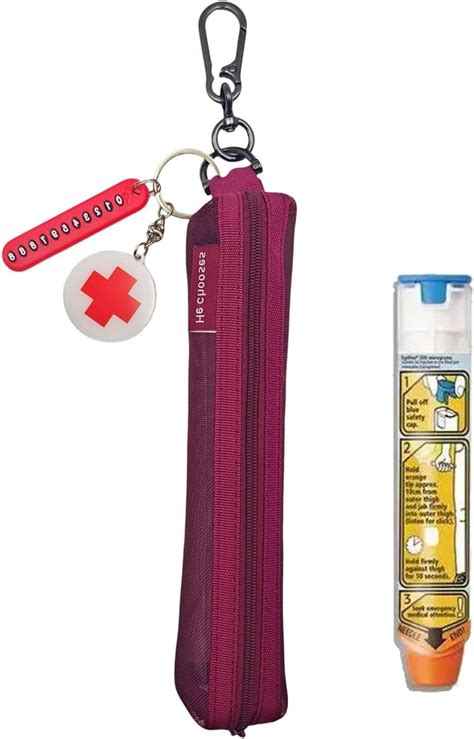Introduction
Allergies, especially anaphylaxis, can be life-threatening emergencies. For individuals with severe allergies, carrying an epinephrine auto-injector (EpiPen) is crucial for prompt and effective treatment. A carrying case for an EpiPen offers essential protection and convenience, ensuring the device is always accessible during an allergic reaction.

Importance of EpiPen
According to the Centers for Disease Control and Prevention (CDC), approximately 10% of children and 4% of adults in the United States have a food allergy. Additionally, the American Academy of Allergy, Asthma & Immunology (AAAAI) estimates that anaphylaxis affects up to 150,000 Americans annually.
EpiPen is a prescription medication used to treat anaphylaxis by delivering a single dose of epinephrine. Epinephrine works by constricting blood vessels, increasing heart rate, and relaxing smooth muscles in the airways. These effects help to reduce swelling, improve breathing, and raise blood pressure.
Benefits of a Carrying Case
An EpiPen carrying case provides numerous benefits, including:
- Protection: The case protects the EpiPen from damage, such as scratches, dents, or moisture. This ensures the device remains functional and ready for use.
- Accessibility: A carrying case with a clip or keychain attachment allows for quick and easy access to the EpiPen in case of an emergency.
- Identification: Carrying cases often feature clear windows or labels to display the EpiPen and indicate its presence. This helps identify the device quickly, especially in a crowded or stressful situation.
- Convenience: Carrying cases provide a convenient way to transport the EpiPen, making it easy to keep it close at hand throughout the day.
- Peace of mind: Knowing that the EpiPen is protected and accessible provides peace of mind for individuals with severe allergies and their caregivers.
Types of Carrying Cases
Various types of EpiPen carrying cases are available, suited to different lifestyles and preferences.
- Zippered cases: These cases offer complete protection with a zippered closure. They may have additional compartments for medications or medical information.
- Hard-shell cases: Hard-shell cases provide superior protection from impact or crushing. They are ideal for individuals who engage in strenuous activities or travel frequently.
- Belt clip cases: Belt clip cases attach directly to a belt or waistband for easy access and visibility. They are suitable for individuals who prefer to keep the EpiPen close by without carrying a bag or purse.
- Keychain cases: Keychain cases are small and lightweight, allowing the EpiPen to be attached to a keychain or backpack. They are ideal for individuals who need the EpiPen to be within reach at all times.
Tips for Using a Carrying Case
To maximize the effectiveness of an EpiPen carrying case:
- Keep the case clean: Regularly clean the case with a disinfectant to prevent the spread of germs.
- Inspect the EpiPen regularly: Check the EpiPen’s expiration date and ensure it is in working order.
- Carry a spare EpiPen: Consider carrying a spare EpiPen in case the first one is not accessible or used during an allergic reaction.
- Inform others: Educate family, friends, and colleagues about the EpiPen and its location.
- Attach the case to a visible location: Place the EpiPen carrying case in a place where it can be quickly identified and retrieved.
Conclusion
A carrying case for an EpiPen is an indispensable tool for individuals with severe allergies. By providing protection, accessibility, and convenience, it ensures that the device is always ready for use during an anaphylactic emergency. Choosing the right type of carrying case and following best practices for its use can significantly improve allergy management and provide peace of mind.
Comparative Table of EpiPen Carrying Cases
| Feature | Zipped Case | Hard-Shell Case | Belt Clip Case | Keychain Case |
|---|---|---|---|---|
| Protection | Good | Excellent | Fair | Fair |
| Accessibility | Moderate | Limited | Excellent | Excellent |
| Identification | Clear window | Label | No window | No window |
| Convenience | Bulky | Heavy | Compact | Lightweight |
| Price | Affordable | Expensive | Moderate | Affordable |
Step-by-Step Guide to Using an EpiPen
- Remove the EpiPen from its carrying case.
- Hold the EpiPen upright with the black tip pointing downward.
- Pull the blue safety cap straight off.
- Press the black tip firmly against the outer thigh at a 90-degree angle.
- Hold for 10 seconds and then release.
- Massage the injection site for 10 seconds.
- Seek medical attention immediately.
Table of Allergy Statistics
| Statistic | Source |
|---|---|
| 10% of children have a food allergy | CDC |
| 4% of adults have a food allergy | CDC |
| Anaphylaxis affects up to 150,000 Americans annually | AAAAI |
| Food allergies are the leading cause of anaphylaxis in children | AAAAI |
Infrequently Used Word
Epipenystron – A hypothetical device that combines the EpiPen with a wearable sensor to monitor allergy symptoms and provide real-time alerts.
Innovations in EpiPen Technology
- Auto-activated EpiPens: These devices use sensors to detect anaphylaxis and automatically administer epinephrine without the need for manual activation.
- Wearable EpiPens: These devices are worn like a bracelet or necklace and can deliver epinephrine through a small needle patch.
- Smart EpiPens: These devices connect to a smartphone app to track medication usage, provide reminders, and share data with healthcare providers.
